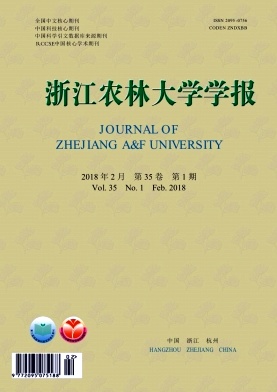-
硫代葡萄糖苷(glucosinolates,GS),简称硫苷,又称芥子油苷,是植物中一类富含氮硫的阴离子次生代谢物质,主要存在于十字花科Cruciferae,尤其是芸薹属Brassica植物中,如白菜Brassica rapa ssp. pekinensis,甘蓝Brassica oleracea,油菜Brassica napus,芥菜Brassica juncea,芜菁Brassica rapa,拟南芥Arabidopsis thaliana等[1]。自从BUSSY[2]于1839年从芥菜子中首次发现硫苷后,硫苷的种类以及降解产物逐渐被人所认识。目前,鉴定出结构的硫苷已经超过132种[3]。所有硫苷都有一个共同的化学结构:一般由β-D-硫葡萄糖基、硫化肟基团以及来源于氨基酸的侧链R基团组成。根据氨基酸侧链R基团的不同,可将硫苷分为3类:脂肪族硫苷(侧链主要来源于甲硫氨酸、丙氨酸、缬氨酸、亮氨酸或异亮氨酸),吲哚族硫苷(侧链主要来源于色氨酸)和芳香族硫苷(侧链主要来源于苯丙氨酸或酪氨酸)[1, 4]。硫苷本身性质比较稳定,并不具备生物活性,主要存在于植物细胞的液泡中,而硫代葡萄糖苷酶(又称黑芥子酶)则位于特定的蛋白体中,只有当植物组织破碎时(如病虫害侵袭或机械损伤),两者得以接触,硫苷在黑芥子酶的作用下水解产生异硫氰酸盐、硫氰酸脂、腈类等生物活性物质[4]。这些水解产物具有重要的生物学功能,不仅是十字花科蔬菜独特风味物质的主要来源,而且在抵御昆虫取食[5-7]、病原菌侵染[8]以及各种非生物胁迫[9](如水分、温度、光照、盐胁迫)等植物防卫反应中也发挥了重要作用,更重要的是它对人体而言具有预防结肠癌、乳腺癌、肺癌等癌症发生的作用[10-11]。经过数十年的研究,硫苷的生物合成途径及其调节基因在模式植物拟南芥中已经基本阐明[12-14]。硫苷的生物合成过程主要包括以下3个阶段:氨基酸侧链的延长,核心结构的形成和侧链的次级修饰[12]。在硫苷核心结构形成过程中,硝基化合物或氧化腈在谷胱甘肽硫转移酶(gultathione-S-transferase,GST)的作用下与硫供体(半胱氨酸或谷胱甘肽)结合,形成S-烷基硫代氧肟;以及脱硫硫苷在磺基转移酶(sulfotransferase,SOT)的催化下,与高能硫供体3′磷酸腺苷5′磷酰硫酸(3′-phospho-adenosine-5′-phosphosullfate,PAPS)结合,在N末端生成一个SO42-,从而形成基本的硫苷结构。这2步反应都需要硫供体,也使得最终的硫苷中含有大量的硫元素且被运送到种子中储存起来,用于应对缺硫胁迫,保证植物体内的硫平衡[15]。笔者总结了近年来硫苷生物合成过程中硫来源的研究进展,并在此基础上分析了初生硫代谢与硫苷合成的关系,希望进一步完善硫苷的代谢网络,为日后研究硫的初生与次生代谢途径间的相互作用提供理论指导。
HTML
-
半胱氨酸(cysteine,Cys)是硫营养代谢的枢纽,植物吸收的无机硫经过一系列还原和同化反应进入有机骨架,形成Cys;植物以Cys为前体,合成众多具有重要生物学功能的含硫化合物;因此,Cys在细胞内的积累量很低,但通量很高[16]。一直以来,Cys被认为是硫苷合成过程中的还原硫供体,在GST或者GST类似功能酶的催化下与硝基化合物或者氧化腈结合形成S-烷基硫代氧肟。同位素标记的体内试验表明:半胱氨酸比甲硫氨酸等硫醇类物质更易参与到硫苷的合成过程;但是,体外试验表明:硫醇类物质都易与硝基化合物结合[17]。而最近的研究表明,谷胱甘肽也可以为硫苷的合成提供还原硫。
-
谷胱甘肽(glutathione,GSH),是由谷氨酸、半胱氨酸和甘氨酸组成的三肽化合物,是植物体内广泛存在的生物活性物质,其活性位点为半胱氨酸的巯基[18-19]。巯基的存在使其具有很强的还原能力;此外,谷氨酸与半胱氨酸之间存在1个不多见的γ-肽键能够保护GSH不被许多肽酶水解[18]。GSH特殊的化学结构使其具有重要的生物学功能。它在还原硫的储存和转运,酶活性的调节,清除活性氧,抵抗各种逆境胁迫(重金属、干旱胁迫、盐胁迫、病菌侵染)等方面都具有重要作用[20-26]。最近的研究表明:GSH也可以作为还原硫供体与硝基化合物或者氧化腈结合,直接参与硫苷的生物合成过程。
首次指出GSH参与硫苷合成的试验来自于对pad2突变体的分析,此突变体缺失γ-谷氨酰半胱氨酸合成酶(γ-Glu-Cys synthetase,GSH1)[27],即GSH合成的关键酶,突变体的GSH含量只有野生型的20%,同时Cys含量上升了5倍,但是与野生型相比硫苷的含量却没有显著变化;而经过24 h的昆虫(夜蛾Noctuidae)诱导,突变体的吲哚-3-甲基硫代葡萄糖苷和4-甲基亚磺酰丁基硫代葡萄糖苷的含量只有野生型的50%[17, 28],这就说明GSH与硫苷的合成存在一定的关系,但是由于GSH功能的复杂性,具体关系在此研究中并未阐明。
GEUFLORES等[29]利用基因工程手段在烟草Nicotiana tabacum中首次证明了GSH可以为硫苷合成提供还原硫。当苯甲基硫代葡萄糖苷(benzylgulcosinolate,BGLS)合成基因(CYP79A2,CYP83B1,SUR1,UGT74B1,SOT16)在烟草叶片中共表达时,产生低含量的BGLS,但同时积累了GSH与硝基化合物的共轭物(S-[(Z)-phenylacetohydroximoyl]-L-glutathione,GS-B)[29]。这是因为C-S裂解酶(C-S lyase,SUR1)不能催化谷氨酸与半胱氨酸之间的γ-谷酰基的水解。这就意味着存在一个酶对γ-谷酰基具有水解作用。然而,有类似功能酶的γ-谷酰基转肽酶家族(GGT家族)定位于非原质体或者是液泡,而硫苷的合成定位于细胞质,这就排除了GGT酶在硫苷合成中的作用[30]。另外,在大肠埃希菌Escherichia coli中也发现了具有类似功能的酶,此酶含有一个γ-谷酰基转移酶结构域[30]。而当含有同型结构域的γ-谷酰基水解酶(γ-glutamyl peptidase,GGP)重组体在上述烟草叶片中共表达时,GS-B的积累下降,BGLS的含量上升(大约5倍),这就证明了非GGT家族的γ-谷酰基水解酶的存在[29]。此外,体外试验也证明了GGP1可以催化γ-谷酰基的水解。
以上在不合成硫苷的植物(烟草)中证明了GSH为硫苷的合成提供硫,并且证明了GGP1对γ-谷酰基的水解作用,但还需要证明在含有硫苷的植物中也存在这种机制。GEUFLORES等[31]又以模式植物拟南芥的GGP1和GGP3的双突变体为研究对象,研究表明此突变体的硫苷含量显著下降,并且积累了10种GSH与硝基化合物的共轭物;同时亚细胞定位表明,GGP1和GGP3定位于细胞质,这与硫苷合成的相关酶系相一致,这就为GSH可以作为硫苷合成过程中的还原硫供体提供了更为明确和直接的证据,而且也进一步证明GGP对γ-谷酰基的水解作用。然而,GGP1和GGP3的双突变体中仍然含有大量的硫苷,这说明可能还存在其他的γ-谷酰基水解酶,有待于进一步研究和确认[30]。
1.1. 半胱氨酸(Cys)作为还原硫供体
1.2. 谷胱甘肽(GSH)作为还原硫供体
-
高能硫供体3′磷酸腺苷5′磷酰硫酸(PAPS)是活化硫酸盐在细胞内的积累形式,也是磺基转移酶(SOT)作用的底物[32]。在硫苷核心结构合成的最后一步,PAPS在SOT的作用下将硫酸根(SO42-)转移至脱硫硫苷的羟基,形成基本的硫苷结构[33]。目前,在拟南芥中发现磺基转移酶家族共有18个成员,根据编码序列的同源性可分成7个亚家族,主要功能是催化硫苷、黄酮、植物磺肽素等次生代谢物的硫酸化反应[34]。其中,SOT16,SOT17和SOT18主要负责硫苷的硫酸化反应,表达水平受到组织器官、生长阶段以及光照条件等的影响,且具有不同的底物专一性,SOT16主要催化吲哚族和芳香族硫苷的硫酸化反应,而SOT17和SOT18对长链的脂肪族脱硫硫苷具有更高的亲和性[34-35]。
PAPS是植物吸收的SO42-在腺苷三磷酸(adenosine triphosphate,ATP)的参与下由ATP硫酸化酶(ATP sulfurylase,ATPS)和APS激酶(APS kinase,APK)催化合成。目前,在拟南芥中发现APK家族共有4个成员,而只有apk1apk2双突变体的硫苷含量显著减少,同时积累了大量的脱硫硫苷[34, 36-37]。且亚细胞定位表明:硫苷的合成定位于细胞质(SOT16,SOT17和SOT18均位于细胞质),而APK基因家族中只有APK3位于细胞质,APK1,APK2和APK4均位于叶绿体[34, 37]。这说明存在一个转运机制将PAPS从叶绿体转运至细胞质以供硫苷的合成。近来的研究证实了PAPS转运蛋白(PAPS transporter,PAPST1)可以顺着浓度梯度将PAPS跨膜转运至细胞质[37]。
进一步的研究表明:PAPS脱去硫酸根后的产物3′, 5′磷酸腺苷(3′, 5′-phosphoadenosine,PAP)具有细胞毒性(抑制RNA酶对畸形RNA的分解作用),而PAPST1可以顺着浓度梯度将PAP转运至叶绿体,在叶绿体中存在PAP磷酸酶(PAP phosphatase,FRY1)催化PAP降解形成腺苷酸(adenosine monophosphate, AMP)[37]。因此,在PAPST1顺浓度梯度跨膜转运机制的基础上,PAPS的合成与利用以及PAP的降解相互作用,共同调控硫苷的生物合成途径。缺失PAPST1的拟南芥突变体硫苷含量也显著减少且积累了脱硫硫苷,但是积累程度不及apk1apk2双突变体,说明可能还存在其他的PAPS转运体,还有待于进一步研究确认。同时这也说明了SOT催化的脱硫硫苷的硫酸化作用不仅受到低浓度PAPS的抑制,而且当PAPS/PAP的转运机制失调时,此反应也受到抑制[37]。
-
植物根部吸收的硫酸盐,在多种硫酸盐转运蛋白的协同作用下,通过木质部和韧皮部,最终进入叶绿体或质体被ATPS活化形成5′腺苷磷酸硫酸(adenosine 5′-phosphosulfate,APS)[16, 38-39]。APS在能量上是不稳定的,可以被APS还原酶(APS reductase,APR)还原形成SO32-,进入硫的初生代谢途径,形成半胱氨酸、谷胱甘肽、甲硫氨酸等含硫化合物,并进一步为硫苷等次生代谢物的合成提供原料;也可以在APK的作用下磷酸化形成PAPS,PAPS进入次生代谢途径,为硫苷等次生代谢物的合成提供活化硫酸盐[34, 37]。因此,硫苷的合成与硫代谢间有着密切的关系。
-
初生硫代谢为硫苷的合成提供了前体氨基酸(甲硫氨酸,Met),还原硫供体(Cys和GSH)以及活化硫酸盐(PAPS),而硫苷的合成受植物体内硫营养水平的调控。研究表明:增施硫肥能够显著提高植物体内硫苷的积累[40];而在缺硫条件下,拟南芥的硫苷合成基因的表达下调,黑芥子酶编码基因的表达上调,说明植物一方面通过减少硫苷的合成以降低次生代谢对硫的利用,另一方面增加其降解以提高硫从次生代谢向初生代谢的转化,以缓解缺硫胁迫,保证植物正常的生长发育[41]。HUSEBY等[42]研究表明:光照条件下,硫酸盐转运蛋白、APR等初生硫代谢基因表达上调,同时硫苷合成基因的表达也上调,硫苷含量上升。此外,Met是合成脂肪族硫苷的前体氨基酸,而与吲哚族和芳香族硫苷相比,脂肪族硫苷对环境供硫水平的反应更为灵敏[41]。
-
初生硫代谢与硫苷合成的调控机制错综复杂,受到APK和APR等硫代谢关键基因,MYB等硫苷合成转录因子以及细胞内的氧化还原水平等多方面的影响。
在硫代谢途径中,APS可以在APK的作用下,与ATP反应形成PAPS,PAPS为硫苷的合成提供活化硫酸盐;或者在APR的作用下,进入硫的还原和同化途径[16, 39],因此,APS成为硫初生与次生代谢途径的分支点,APK和APR则成为重要的调控因子。MUGFORD等[36]研究表明,apk1apk2拟南芥突变体的硫苷含量只有野生型的15%,微阵列分析显示硫苷合成基因(UGT74B1,CYP83B1,SUR1,SOT16,SOT18)的转录水平上调,脱硫硫苷积累;PAPS合成受阻导致初生硫代谢途径上调,Cys和GSH的含量显著上升,但是APS含量下降,APR活性没有明显的变化;而硫酸盐转运基因以及ATPS(ATPS1和ATPS3)表达的上调可能是受到PAPS不足的诱导[34]。在APK过量表达的材料中,硫苷含量并没有显著变化(尽管MAM3和SOT17的转录水平上调),但是APR活性受诱导,进入初生硫代谢的通量上升[34, 37]。APR是硫还原同化途径的重要调控因子,并受Cys和GSH的反馈抑制,即缺硫会导致APR的活性显著升高;而当Cys或者GSH浓度高时,APR的活性就会受到抑制,这也体现了硫代谢途径受需求驱动的特点[16, 39]。
MYB是一类转录因子,能在转录水平上通过调节与其相关的基因的表达来调控硫苷的合成[12]。其中,MYB28,MYB29和MYB76能够调控脂肪族硫苷的合成,MYB34,MYB51和MYB122能够调控吲哚族硫苷的合成[12]。研究表明:MYB也可以直接调控ATPS和APR等初生硫代谢基因[39]。MYB的过量表达导致ATPS1和ATPS3的转录水平上调,硫初生代谢途径受诱导,GSH含量上升;而缺失MYB的突变体中,APR的转录水平下调[34]。
此外,初生硫代谢与硫苷的合成还受到细胞内氧化还原水平的调节。研究表明:APR受氧化应激的诱导,而APK在还原产物含量高时活性更高。当植物处于胁迫状态时,活性氧的产生导致APR活性上升,而APK活性受抑制,硫的初生代谢途径上调[34, 37]。因此,当细胞处于氧化状态时,硫进入初生代谢的通量提高,而当细胞处于还原状态时,硫更倾向于进入硫苷合成等次生代谢途径。
3.1. 初生硫代谢为硫苷的合成提供原料
3.2. 初生硫代谢与硫苷合成的调控机制
-
硫苷是十字花科植物一类富含氮硫的次生代谢物,因硫苷作为十字花科蔬菜风味物质的来源被人们认识已久,而且硫苷及其降解产物因在植物防御以及降低人体癌症发生率方面的重要生物学功效而受到越来越广泛的关注。到目前为止,硫苷的生物合成过程及其调控基因在模式植物拟南芥中已经基本阐明。硫苷作为植物体内有机硫的重要储存形式,其合成过程也伴随着硫的还原和同化,且硫还原同化途径产物Cys和GSH是硫苷合成过程中的还原硫供体,PAPS则为硫苷的合成提供了活化硫酸盐,因此硫苷的合成与硫的还原和同化途径(初生硫代谢途径)间有着密切的联系。但是硫的初生代谢与硫苷的合成受到APK和APR等硫代谢关键基因,MYB等硫苷合成转录因子以及细胞内的氧化还原水平等多方面的影响,其调控机制错综复杂,还存在许多悬而未决的问题,比如硫营养信号转导、硫与氮等其他营养元素之间的协调、葡萄糖等植物激素之间的信号交流对硫苷合成的生物调控,这都有待于进一步研究,以明确硫的初生代谢与次生代谢途径间的相互作用。此外,以GSH作为硫苷合成的还原硫供体时,是否还存在羧肽酶的水解作用还不明确,尚需进一步探究;GGP的具体作用机制仍处于推论阶段,仍需进一步研究;GSH的动态平衡对硫苷合成的调控作用也是人们关注的问题,也有可能成为新的研究热点。随着科学研究的不断深入,在未来可以利用遗传学、蛋白组学、代谢组学、基因工程等手段人为操纵硫苷的生物合成,这对提高作物对病虫害的抗性、作物的抗癌活性以及新品种的选育和改良具有十分重要的意义。






 DownLoad:
DownLoad: